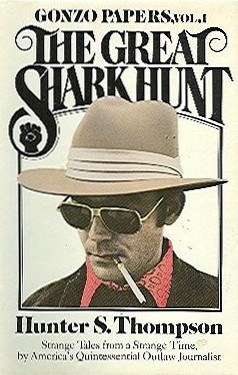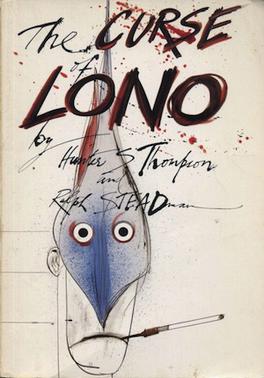
Gonzo journalism is a style of journalism that is written without claims of objectivity, often including the reporter as part of the story using a first-person narrative. The word "gonzo" is believed to have been first used in 1970 to describe an article about the Kentucky Derby by Hunter S. Thompson, who popularized the style. It is an energetic first-person participatory writing style in which the author is a protagonist, and it draws its power from a combination of social critique and self-satire. It has since been applied to other subjective artistic endeavors.

Hunter Stockton Thompson was an American journalist and author. He rose to prominence with the publication of Hell's Angels (1967), a book for which he spent a year living with the Hells Angels motorcycle club to write a first-hand account of their lives and experiences. In 1970, he wrote an unconventional article titled "The Kentucky Derby Is Decadent and Depraved" for Scanlan's Monthly, which further raised his profile as a countercultural figure. It also set him on the path to establishing his own subgenre of New Journalism that he called "Gonzo", a journalistic style in which the writer becomes a central figure and participant in the events of the narrative.

Oscar "Zeta" Acosta Fierro was a Mexican American attorney, author and activist in the Chicano Movement. He wrote the semi-autobiographical novels Autobiography of a Brown Buffalo (1972) and The Revolt of the Cockroach People (1973), and was friends with American author Hunter S. Thompson. Thompson characterized him as a heavyweight Samoan attorney, Dr. Gonzo, in his 1971 novel Fear and Loathing in Las Vegas. Acosta disappeared in 1974 during a trip in Mexico and is presumed dead.

Raoul Duke is the partially fictionalized author surrogate character and sometimes pseudonym used by Hunter S. Thompson as the main character and antihero for many of his works. He is perhaps best known as the narrator for his 1971 autobiographical novel Fear and Loathing in Las Vegas. The book was originally written under the name Raoul Duke. The character wears a bucket hat and yellow tinted aviator sunglasses.
"The Kentucky Derby Is Decadent and Depraved" is a seminal sports article written by journalist Hunter S. Thompson on the 1970 Kentucky Derby, which first appeared in Scanlan's Monthly in June of that year. The article marked the birth of what would become known as "gonzo journalism".

Flying Dog Brewery was a craft brewery located in Frederick, Maryland, United States. It was founded in 1990 by George Stranahan and was the largest brewery in Maryland. In 2017, it was the 28th largest craft brewery in the United States.

The Great Shark Hunt is a book by Hunter S. Thompson. Originally published in 1979 as Gonzo Papers, Vol. 1: The Great Shark Hunt: Strange Tales from a Strange Time, the book is a roughly 600-page collection of Thompson's essays from 1956 to the end of the 1970s, including the rise of the author's own gonzo journalism style as he moved from Air Force and sports beat writing to straight-ahead political commentary. It is the first of what would become four volumes in The Gonzo Papers series.

Where the Buffalo Roam is a 1980 American semi-biographical comedy film which loosely depicts author Hunter S. Thompson's rise to fame in the 1970s and his relationship with Chicano attorney and activist Oscar "Zeta" Acosta. The film was produced and directed by Art Linson. Bill Murray portrayed Thompson and Peter Boyle portrayed Acosta, who is referred to in the film as Carl Lazlo, Esq. A number of other names, places, and details of Thompson's life are also changed.
Omnibus is a British documentary series broadcast mainly on BBC One. The programme was the successor to the arts-based series Monitor.

The Curse of Lono is a book by Hunter S. Thompson describing his experiences in Hawaii in 1980. Originally published in 1983, the book was only in print for a short while. In 2005 it was re-released as a limited edition. Only 1000 copies were produced, each one being signed by the author and artist Ralph Steadman.The book is now available as a smaller hardcover edition.

Fear and Loathing in Las Vegas is a 1998 American stoner road black comedy film adapted from Hunter S. Thompson's 1971 novel of the same name. It was co-written and directed by Terry Gilliam, and stars Johnny Depp and Benicio del Toro as Raoul Duke and Dr. Gonzo, respectively. The film details the duo's journey through Las Vegas as their initial journalistic intentions devolve into an exploration of the city under the influence of psychoactive substances.

Fear and Loathing in Las Vegas: A Savage Journey to the Heart of the American Dream is a 1971 novel in the gonzo journalism style by Hunter S. Thompson. The book is a roman à clef, rooted in autobiographical incidents. The story follows its protagonist, Raoul Duke, and his attorney, Doctor Gonzo, as they descend on Las Vegas to chase the American Dream through a drug-induced haze, all the while ruminating on the failure of the 1960s countercultural movement. The work is Thompson's most famous book and is noted for its lurid descriptions of illicit drug use and its early retrospective on the culture of the 1960s. Thompson's highly subjective blend of fact and fiction, which it popularized, became known as gonzo journalism. Illustrated by Ralph Steadman, the novel first appeared as a two-part series in Rolling Stone magazine in 1971 before being published in book form in 1972. It was later adapted into a film of the same title in 1998 by director Terry Gilliam, starring Johnny Depp and Benicio del Toro, who portrayed Raoul Duke and Dr. Gonzo, respectively.

Gonzo Papers, Vol. 3: Songs of the Doomed: More Notes on the Death of the American Dream is a book by the American writer and journalist Hunter S. Thompson, originally published in 1990. This third installment of The Gonzo Papers is a chronologically arranged selection of stories, letters, journals and reporting, allowing readers to see how Thompson's brand of "new journalism," also termed Gonzo journalism, has evolved over the years. It is a collection of Dr. Thompson's essays and articles. This collection is mostly made up of pieces from the Reagan Era, but there are also some older stories, including excerpts from his unfinished first novel, "Prince Jellyfish", which is still unpublished, and The Rum Diary, which was not published on its own until 1998.
Bibliography of works by American author and journalist Hunter S. Thompson.

The Joke's Over: Bruised Memories—Gonzo, Hunter S. Thompson, and Me is a book written and illustrated by Ralph Steadman chronicling the odd and very often dangerous times when he met and worked with his friend Hunter S. Thompson. It contains some illustrations by Steadman created at the time of the events and some photos taken by Steadman or Thompson. It was published in 2006 by Heinemann in the UK and, perhaps during the same year, by Harcourt in the US.

Gonzo: The Life and Work of Dr. Hunter S. Thompson is a 2008 documentary film directed by Alex Gibney. It details Hunter S. Thompson's landmark writings on music and politics. Friends and family provide interviews to help describe the mythos of Hunter and his life.
Fear and Loathing on the Road to Hollywood, also known as Fear and Loathing in Gonzovision, is a documentary film produced by BBC Omnibus in 1978 on the subject of Hunter S. Thompson, directed by Nigel Finch.

Warren James Hinckle III was an American political journalist based in San Francisco. Hinckle is remembered for his tenure as editor of Ramparts magazine, turning a sleepy publication aimed at a liberal Roman Catholic audience into a major galvanizing force of American radicalism during the Vietnam War era. He also helped create Gonzo journalism by first pairing Hunter S. Thompson with illustrator Ralph Steadman.

Gonzo Today is an internet-based publication inspired by the writing and reporting style of gonzo journalism popularized by Hunter Thompson.

Huncho Jack, Jack Huncho is the only studio album by American hip hop duo Huncho Jack, which consists of American rappers Travis Scott and Quavo. The album was released on December 21, 2017, by Cactus Jack Records, Grand Hustle Records, Epic Records, Capitol Records, Motown, and Quality Control Music. It features guest appearances from fellow Migos members, Takeoff and Offset. Production was handled by Murda Beatz, Southside, and Frank Dukes, among others.


















